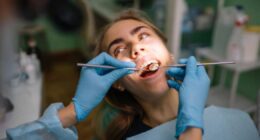“Having good oral health is imperative for our physical and psychological well-being,” says Dani Benyaminy, DDS, a cosmetic dentist based in Los Angeles. “Nonetheless, most folks fail to realize how important oral health is until there is a major issue that forces them to rethink their routines.” Such issues include but aren’t limited to enamel erosion, tooth decay, gum disease, discoloration, and bad breath. Arguably, the lot of us wouldn’t prefer to wait to course-correct after any of these scenarios come into play, which is why Dr. Benyaminy encourages us to be more proactive to support oral health.
One simple tip we can enact from this day forward takes only a few seconds but can make a major difference in the long run: rinsing after drinking highly acidic beverages. Ahead, see how a quick post-sip swish can save your smile, plus which drinks have the potential to be the biggest offenders.
Why you should rinse your mouth after drinking acidic beverages
Dr. Benyaminy says that overexposure to highly acidic drinks increases the risk of enamel erosion. (As a friendly reminder, enamel is the outer protective layer of your teeth.) “Enamel erosion increases the risk for decay, sensitivity, staining, and in some cases increased tooth wear and/or fracture,” he explains. Again, not a single one of these scenarios is ideal to address after the fact, which is why taking greater care of our oral health via protective daily habits is crucial. “The truth is that you can have the dental health of your dreams if you are willing to do the work to make it happen,” Dr. Benyaminy says.
Enter: making it habitual to head to the sink for a quick swish-and-spit after sipping on acidic bevs. “This helps to neutralize the acid by bringing the pH levels inside your mouth up,” says Dr. Benyaminy. (Another friendly reminder for those of us, myself included, who weren’t the strongest students in high school chemistry: “A neutral pH is considered to be seven. Anything that lowers that value is considered to be acidic,” he explains.)
Acidity aside, some of these beverages contain added sugar, which amplifies the risk of damage to your teeth. “Bacteria in the mouth feed off the sugar and create an acidic byproduct that further increases the risk for erosion and decay,” Dr. Benyaminy shares.
4 highly acidic drinks that can lead to enamel erosion
1. Soda with added sugar
It’s no surprise that sugary sodas aren’t great for your health at large—and this fact extends to oral health, too. Dr. Benyaminy says that they’re amongst the most highly acidic beverages around, with a pH level around 2.5 to 3.5. When consumed regularly and consistently, these carbonated drinks “erode tooth enamel over time, increase the risk of cavities, and cause noticeable staining due to the combination of acids and sugars,” he says.
READ RELATED: This 2-Ingredient Brazilian-Inspired Lemonade Is Bound To Be Your Hydrating Main Squeeze All Summer Long
2. Fruit juices
Dr. Benyaminy notes that store-bought fruit juices also aren’t stellar for oral health, again due to their high acidity and sugar content. He calls out apple juice (with pH levels ranging from 3.0 to 4.0) and orange juice (with pH levels ranging from 3.3 to 4.2) in particular. Despite the nutritional benefits of each—such as their antioxidant content and ability to count towards your daily fruit intake, if they are, in fact, 100 percent fruit juice—you’ll still want to be mindful of your intake. “They can contribute to tooth erosion and enamel damage if consumed regularly and in large quantities,” the dentist notes.
3. Coffee
As *amazing* as coffee is (IMHO) for its taste, antioxidant profile, and of course the energetic boost it provides, it’s less of an all-star in the dental department. Yes, it has the ability to stain your teeth—and it’s also pretty acidic depending on which brew you choose. “Coffee generally has a pH of 5-5.5,” says Dr. Benyaminy. However, he continues to say that cold brew tends to be less acidic due to the extraction process. Whether oral health, digestive upset, or both concern you, you may want to opt for the cold stuff. You can also purchase low-acid coffee or rely on creamer, extra water, or even baking soda to tamper down acidity.
4. Sparkling water
While sparkling water has many merits—including but not limited its ability to hydrate you as much as plain H2O will—they, too, should be followed up with a quick rinse. “Sparkling water is a great alternative to regular sodas. However, it is still acidic,” Dr. Benyaminy explains. He also notes that those with added flavors tend to be more acidic than others.
Final tips
While you don’t need to restrict these acidic drinks completely, rinsing after consuming them can protect your enamel and teeth more efficiently in the long-term. In addition, Dr. Benyaminy suggests using a straw, when possible, to bypass the fluids’ direct exposure to your teeth.
He also advises against prolonged sipping. “The longer your teeth are exposed to the acidic drink, the more detrimental it is,” Dr. Benyaminy concludes.
Source




